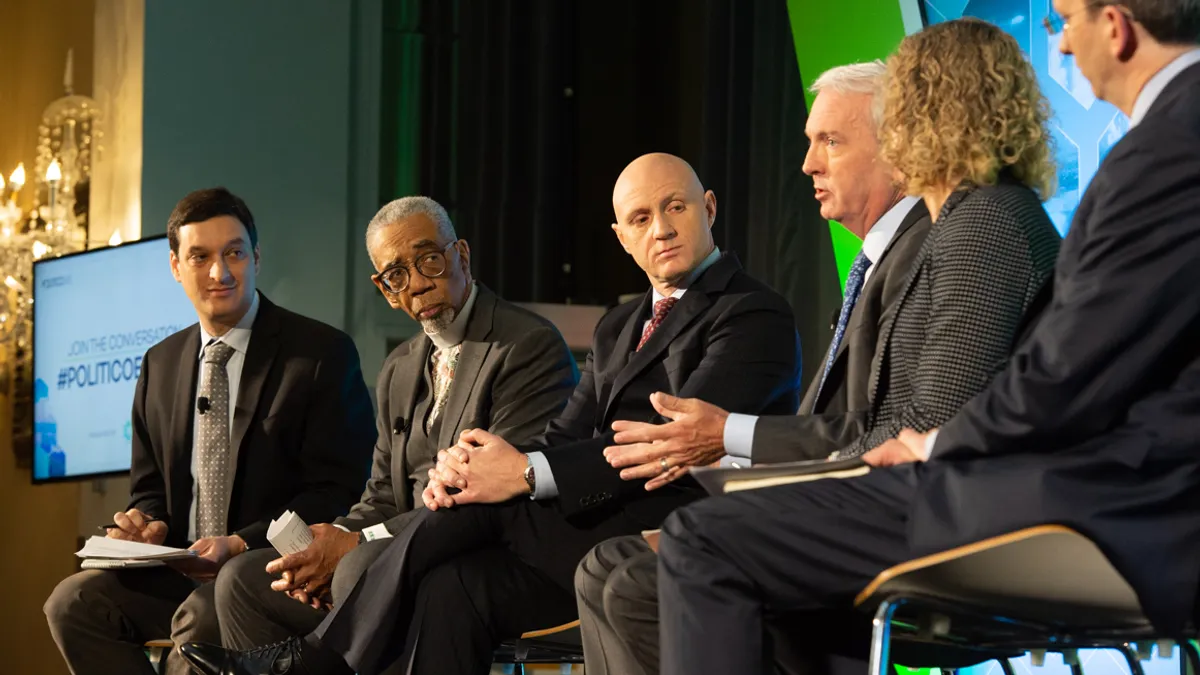Regulatory cuts on efficiency and emissions standards have been an undisputed mark of the Trump administration's agenda in the energy sector, prompting outrage from environmentalists about lack of oversight in the industry.
Renewable energy, on the other hand, has for several years been a growing force in the market as prices for the resource continue to fall. But the transition toward affordable wind and solar has been developed under intentional regulatory attention, and that same federal effort is necessary to advance the technologies needed to accelerate the U.S. toward a carbon-free future, according to a report released Wednesday and commissioned by the energy investment coalition Breakthrough Energy.
"We have to make sure the regulation is as innovative as the technologies," Ben Fowke, CEO of Xcel Energy, which in December became the largest multi-state utility to commit to 100% clean energy, told Utility Dive after Politico's Clean Energy Innovation: The Path Forward event.
As more corporations, utilities and states commit to a 100% clean energy future, the pressure on the sector to continue innovating is mounting, and the regulatory sphere will have an important hand in how quickly progress is made, said authors of the report.
The path forward
The push toward low carbon is here and "we're not going back," said Ernest Moniz, former U.S. Secretary of Energy, President and CEO of Energy Futures Initiative, and coauthor of the new report, during the Politico event.
"We're going there, the real question is the extent we can accelerate that transition," he said.
Competitive pricing has been the main driver of wind and solar deployment, but record low prices didn't come overnight, said Daniel Yergin, vice chairman at IHS Markit and coauthor of the report.
"Clean energy 1.0" took years of regulatory time and capital investment in a sector that depends on reliability and safety, said Yergin. It will take an "ongoing commitment" to get those same results from technologies still nascent to the market, but necessary to the transition.
Those technologies include battery storage, especially seasonal, non-lithium ion batteries, advanced nuclear reactors, electric grid modernization and "hit[ting] hard the other sectors that are hard to decarbonize," such as building standards, said Moniz. The report also lists hydrogen, advanced manufacturing technologies, smart cities, biological sequestration and sunlight to fuels as "high-priority clean energy innovation areas" that are worth the government's time and funding.
Though new technology is key, "incumbents need to be a part of the solution," said Moniz. Existing utilities have the customer base, but "you can't do it without the disruptors" which are the essential technologies moving the sector forward. Integrating distributed resources onto the grid is one example of a tool that can placate utility reliability concerns, while allowing cleaner fuels to advance, Moniz said.
And while the private sector plays an important role in creating much of those technology disruptors, market incentives alone can not propel the necessary deployments forward, said the report. The market and the regulatory landscape need to be ready to support experimentation.
"We are pushing boundaries of how much renewable energy you can have on the big grid," said Fowke. "We have come a long way on energy innovation, but it is complicated. You need to make sure you're investing in the grid."
The government's role
Under the current administration, states have taken a more central role in the clean energy transition, and technology deployment should have regional considerations, said Moniz.
"Trust in innovative outcomes rather than prescriptive outcomes" when it comes to regional deployment, he said. "All the tools are on the table for different geographies."
"To get us to that 100% carbon free, and have reliable energy, which we all count on each and every day, you have to have something that's zero carbon that we can dispatch on command."

Ben Fowke
CEO, Xcel Energy
But while many say federal policy should not play a sweeping role in technology deployment across diverse regions and economies, its role in research and development (R&D) is essential to the kind of large-scale deployment needed to propel utilities like Xcel or states like California, the largest economy committed to 100% clean energy, forward.
Although analysts say Xcel's rapid transition toward clean energy is largely market-based right now, Fowke said that federal R&D into carbon-free technologies not yet commercially available will be a central player in that deployment, so that the utility is able to try out a number of models at an affordable scale.
"To get us to that 100% carbon free, and have reliable energy, which we all count on each and every day, you have to have something that's zero carbon that we can dispatch on command," Fowke told Utility Dive.
"And so, that could be a number of different technologies," he said. "Today, they're not ready for commercial deployment but 2050 is a long way away, so we've got time if we start putting money, time, effort into not only the technology [but] getting it to commercial scale."
The federal government's role in energy funding should focus on R&D, deployment incentives and market-based incentives, said Derek Murrow, senior director of the Climate and Clean Energy Program at the Natural Resources Defense Council, at the event.
"There is Innovation and change everywhere, and if you're the federal government how do you think about ways to encourage that innovation?" asked Murrow, who noted that funding for wind and solar has been threatened in the last year by the DOE, which has increased funding for more "flexible" and "efficient" coal plants.
"Part of our message is the [federal government's] portfolio needs a little more broadening and focusing on more sectors," Moniz told Utility Dive, adding that Congress has shown overall support in propelling "the innovation agenda."
Impacts from the cuts on renewables innovation have been "significant" Murrow told DOE's Assistant Secretary for Energy Efficiency and Renewable Energy, Daniel Simmons at the Politico event. Simmons' office later that afternoon rolled back lightbulb and broad efficiency standards.






















